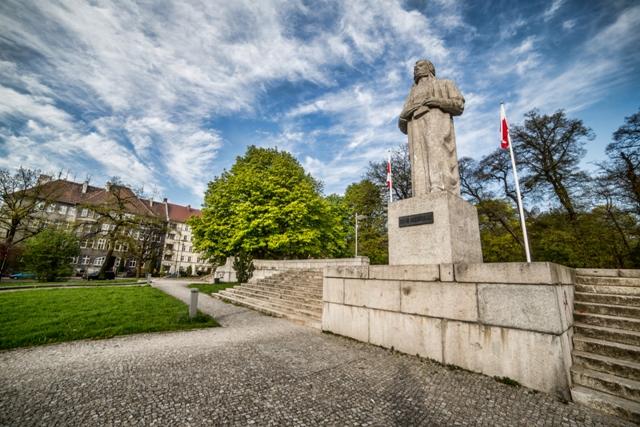Adam Mickiewicz Monument

The figure of the outstanding Polish bard of the Romantic era was placed on the pedestal of the former monument of the Prussian emperor Frederick III. In March 1968, it became a place of memorable student demonstrations against the prevailing socio-political order.
The statue was crafted by a local sculptor Sławomir Lewiński and it was unveiled on 3 May 1960, to commemorate the 1000 years of the Polish State. Adam Mickiewicz’s statue was placed on a pedestal, on which from 1913 to June 1942 stood a bronze equestrian statue of Emperor Frederick III reigning from March 9 to June 15, 1888. That statue was created by Ludwig Manzel.
Adam Mickiewicz monument has been a favourite meeting place for Szczecin’s residents for years. In March 1968 it became a place of memorable student demonstrations against the socio-political order, the pretext of which was the staging of Mickiewicz's play "Dziady" in Warsaw.
Adam Mickiewicz is regarded as the most prominent Polish poet, not only of the Romantic era. Apart from his epic poem “Pan Tadeusz”, he is the author of “Ballads and Romances”, “Dziady”, “Grażyna”, “Konrad Wallenrod”, “Crimean Sonnets” and many more. One of his first works was a 1821 poem entitled “Four toasts of a certain chemist in honour of radiant beings”, or “Vive the electricity!”.
Adam Mieckiewicz’s poetry captivated the eminent Szczecin composer Carl Loewe (1796-1869), who is recognized as the creator of the solo romantic ballad. Here in Szczecin he composed music to our bards ballads, translated into German by Carl von Blankensee: “Czaty” (Der Woywode/The Voivode), “Panicz i dziewczyna” (Der junge Herr und das Maedchen/A Young Man and a Girl), “Pani Twardowska” (Frau Twardowska/Mrs Twardowska), “Pierwiosnek” (Die Schlesselblueme/The Primrose), “Świtezianka” (Das Swiesmaedchen/The Nymph of Świteź), “Trzech Budrysów” (Die drei Budrisse/The Three Lithuanians) and “Wilija, naszych strumieni rodzica” (Wilija und das Maedchen/Wilija and a Girl). The work entitled “Polish Ballads” (Die Polnische Balladen) was published in Germany in 1837.
